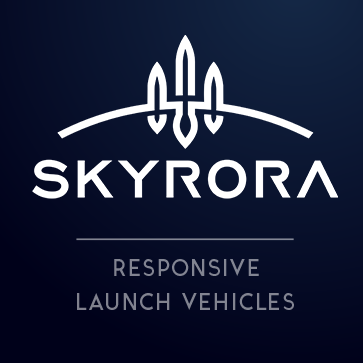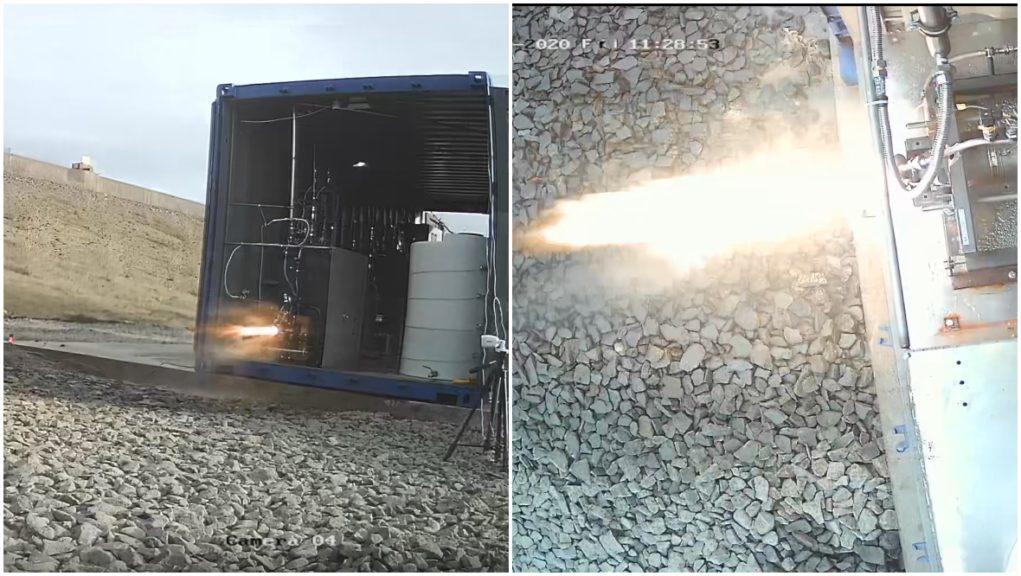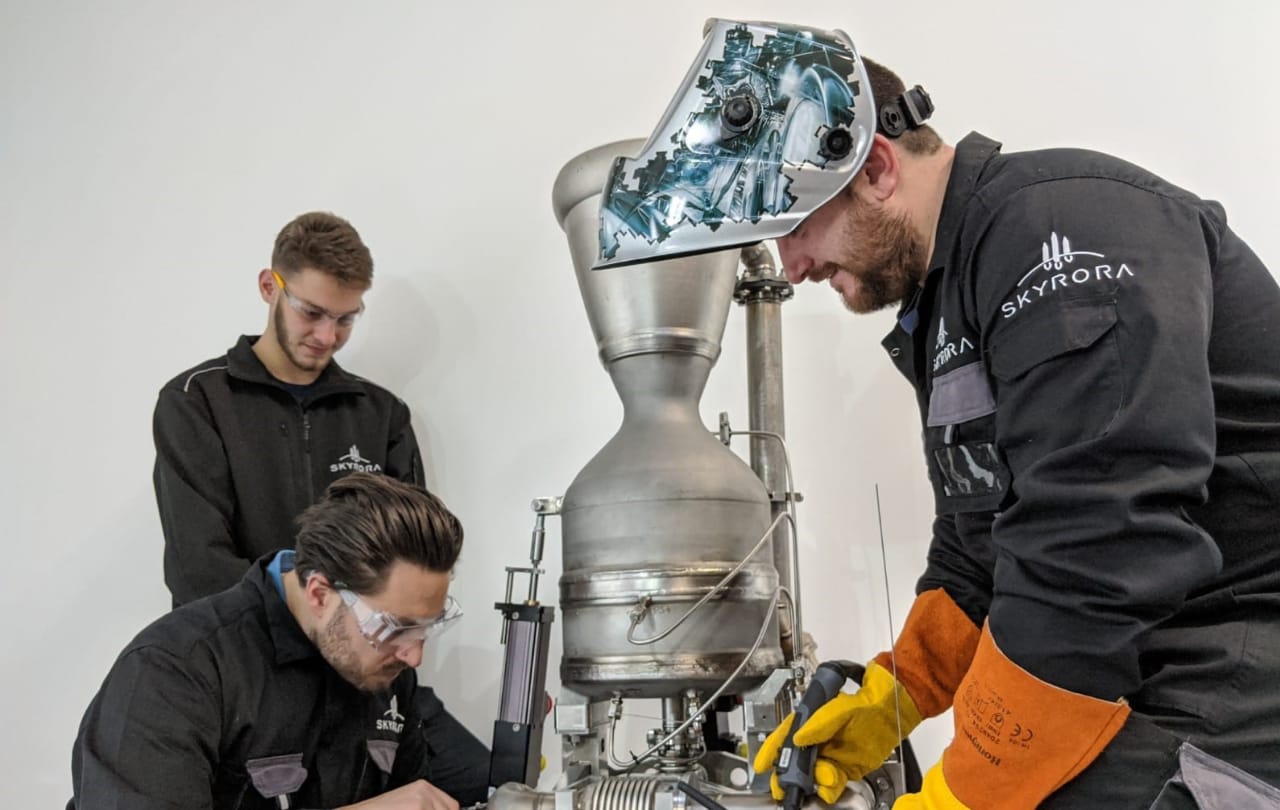In the 1960s, the British space program forged an initiative that led some of the country’s brightest minds to develop rockets, spaceflight capabilities, and satellites at its largest testing facility. The secretly operated site—located on the cliffs of the Isle of Wight, where today only ruins of that golden age endure—helped put Britain, for a brief period of time, at the forefront of space race technology, along with the United States and Russia. Yet, it would take 50 years for the country to regain the momentum needed to launch rockets into space once again. In May 2020, at the Kildermorie Estate in North Scotland, a team of engineers from launch service provider Skyrora built a mobile launch complex where they successfully live-tested a complete rocket vehicle within five days.
Powered by a 3D printed engine, Skyrora’s full-size suborbital launch vehicle, the Skylark L, performed all the actions of launch while restrained to the ground to prevent it from taking off in this, the first vertical static fire test of its magnitude in the U.K. since the Black Arrow Programme ended 50 years ago.
“As the launch aspect of the UK’s new space industry starts to emerge, there will be many events that have never happened here previously and this is one of them. This was a mammoth effort in very trying circumstances, so it is quite an achievement to be proud of,” stated Skyrora’s Chief Executive Officer, Volodymyr Levykin.
“We see this as being the first significant step towards reaching space from our own soil and are very proud to have taken that step as part of the UK’s Space ambitions. We are now in a full state of readiness for launch. It is this milestone that is the start of the UK’s new space revolution, a fantastic example of the potential of what the UK Space holds for the future. With the expertise in place and all the necessary hardware at the ready, we are poised to take the next steps in making the UK a serious leader in the Space business once again.”
As indicated by Levykin, the rocket test operation was carried out while having to adhere to very strict social distancing measures in order to reduce the transmission of the novel coronavirus disease.
According to the company, the full static firing test fully verified the design and in-house manufacturing process, ensuring that the vehicle itself is ready for launch. Skyrora, based at Edinburgh’s Edgefield Industrial Estate, aims to start launching suborbital rockets and move to orbital by 2023, in time for an inaugural launch into low Earth orbit (LEO). Actually, Skyrora indicated that the Skylark L rocket could be ready to propel from British soil as early as spring 2021, although that would require spaceport infrastructure that is not yet expected to be ready by then.
“It is very hard to oversell what we have achieved here with this test; the whole team has pulled through again to deliver another UK first,” said Skyrora Engineering Manager and leader of the Skylark L’s static fire testing, Jack-James Marlow. “We have successfully static tested a fully integrated, suborbital Skylark L launch vehicle in flight configuration. This means we performed all actions of a launch but did not release the vehicle. The rocket engine successfully burned, with all vehicle systems showing nominal operation.”
“This is the first time a launch vehicle of this magnitude has been tested in the UK for many years and I am very proud of my team for achieving this. The vehicle is now ready for flight and we are one step closer to putting the UK back into space,” indicated Marlow.
As Skyrora’s first suborbital flight vehicle, the Skylark L rocket launcher is expected to fly to space, but will not enter into orbit, like the other Skyrora orbital rocket, the Skyrora XL, which is expected to deploy payloads into Polar and Sun Synchronous orbits.
In fact, the Skylark L’s original purpose was to complete final checks on sub-systems prior to use on Skyrora XL. Recently, the Skylark L prototype vehicle has created a new market with universities and research facilities, as the company stated that it can be used for microgravity experiments at a lower cost than an orbital vehicle while taking advantage of the company’s environmentally conscious fuel combination.
The Skylark L is a bi-liquid propellant launch vehicle that uses a propellant combination of hydrogen peroxide and kerosene, a mixture the company says reduces the cost and emissions from launching, and which has been investigated by researchers as one of the best green propellants capable of creating an environmentally safe, self-igniting fuel mixture for liquid-propellant rocket engines. When commercial, the company plans to use its own Ecosene, an equivalent Kerosene fuel that is fully derived from non-recyclable plastic waste, to both reduce emissions and help address the eight million tonnes of plastic being dumped into oceans annually.
The propellants are pressure-fed into a Skyrora 30kN (kilonewton) engine that has been constructed using powder bed fusion technology at the company’s engine test facility in Scotland. Building up to the static fire test, the rocket engine itself has gone through three hot fire tests before integration into the vehicle.
Marlow claimed that “the test did not only validate the vehicle, but it also tested our mobile launch complex’s ground equipment and performed many cold flow and fuel/defuel tests. In all, there were over one hundred unique operations and the team has gained vital experience. This collection of tests, combined with the 25 other engine tests this year, allow us to take another step along our technology roadmap to orbital launch.”
The company suggested that when launched, the suborbital flight vehicle could be ready to reach a height of approximately 100 kilometers, just on the border between the Earth’s atmosphere and outer space, also known as the Karman line, and carry a payload of up to 60 kilograms; this ground test was the first step in that direction.
In order to complete this test, the Skyrora team built a mobile launch complex in record time right in the heart of the Scottish Highlands. During the test, the Skylark L rocket was supported by Skyrora’s transporter-erector mobile system that was fixed to a trailer and used to move the launch vehicle system from its horizontal position on the ground to its vertical state prior to final preparation for launch.
The mobile complex was made up of several modules including a command center, oxidizer, and fuel handling containers and a compressed gas container. Just in case anything went wrong, Skyrora made sure that a team from Bells and Two Tones Fire and Rescue, the leading provider of fire solutions for industrial sites, were on site ready to perform any necessary procedures (fortunately none were needed).
At a time when deep space exploration begins to feel closer than just a futuristic fantasy, advances in suborbital and orbital launching vehicles allow commercial spaceflight to become a practical possibility in the next few years. Successful tests, like the Skylark L ground test, not only represent a step forward for the United Kingdom but validation for companies to continue pushing onward as they prepare to go to space.

The Bells and Two Tones Fire and Rescue team at the testing site in case anything went wrong (Image: Bells and Two Tones Fire and Rescue)
Subscribe to Our Email Newsletter
Stay up-to-date on all the latest news from the 3D printing industry and receive information and offers from third party vendors.
You May Also Like
Gorilla Sports GE’s First 3D Printed Titanium Cast
How do you help a gorilla with a broken arm? Sounds like the start of a bad joke a zookeeper might tell, but it’s an actual dilemma recently faced by...
Nylon 3D Printed Parts Made More Functional with Coatings & Colors
Parts 3D printed from polyamide (PA, Nylon) 12 using powder bed fusion (PBF) are a mainstay in the additive manufacturing (AM) industry. While post-finishing processes have improved the porosity of...
$25M to Back Sintavia’s Largest Expansion of Metal 3D Printing Capacity Since 2019
Sintavia, the digital manufacturing company specializing in mission-critical parts for strategic sectors, announced a $25 million investment to increase its production capacity, the largest expansion to its operations since 2019....
Velo3D Initiates Public Offering in a Bid to Strengthen Financial Foundations and Drive Future Growth
Velo3D (NYSE: VLD) has been among a number of publicly traded 3D printing firms that have attempted to weather the current macroeconomic climate. After posting a challenging financial report for 2023,...


































